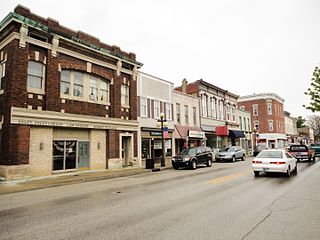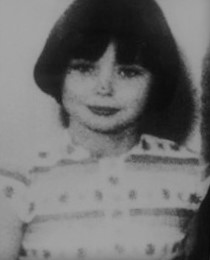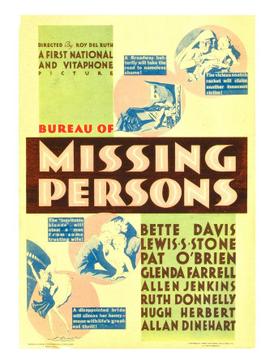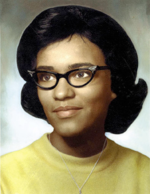
Martinsville is a city in Washington Township, Morgan County, in the U.S. state of Indiana. The population was 12,309 at the 2020 United States Census. The city is the county seat of Morgan County.

Mary Flora Bell is an English woman who, as a juvenile, killed two preschool-age boys in Scotswood, an inner suburb of Newcastle upon Tyne, in 1968. Bell committed her first killing when she was ten years old. In both instances, Bell informed her victim that he had a sore throat, which she would massage before proceeding to strangle him.
Band of Gold is a British television crime drama series, written and created by Kay Mellor, first broadcast on ITV on 12 March 1995. Produced by Granada Television, the series revolves around the lives of a group of prostitutes who live and work in Bradford's red-light district. Principal actresses in the series include Geraldine James, Cathy Tyson, Barbara Dickson, and Samantha Morton. Three series of Band of Gold were produced, with the final episode broadcast on 1 December 1997.
Levi Bellfield is an English serial killer, sex offender, rapist, kidnapper, and burglar. He was found guilty on 25 February 2008 of the murders of Marsha McDonnell and Amélie Delagrange and the attempted murder of Kate Sheedy, and sentenced to life imprisonment. On 23 June 2011, Bellfield was further found guilty of the murder of Milly Dowler. On both occasions, the judge imposed a whole life order, meaning that Bellfield will serve the sentence without the possibility of parole. Bellfield was the first prisoner in history to have received two whole life orders.
Wayne Clifford Boden was a Canadian serial killer and rapist active between 1969 and 1971. Boden killed four women, three in Montreal and one in Calgary, earning the nickname The Vampire Rapist for biting the breasts of his victims, and received four life sentences. Boden's was the first murder conviction in North America due to forensic odontological evidence.

Roseann M. Quinn was an American schoolteacher in New York City who was stabbed to death in 1973 by a man she had met at a bar. Her murder inspired Judith Rossner's best-selling 1975 novel Looking for Mr. Goodbar, which was adapted into a 1977 film directed by Richard Brooks and starring Diane Keaton, and its follow-up fact-based semi-sequel for TV, Trackdown: Finding the Goodbar Killer, released six years later in 1983. Quinn's murder also inspired the 1977 account Closing Time: The True Story of the "Goodbar" Murder by New York Times journalist Lacey Fosburgh. The case was the subject of a Season 3 episode 2 of Investigation Discovery's series A Crime to Remember in 2015.
Dana Sue Gray is an American serial killer who murdered three elderly women in 1994. She was caught after a fourth intended victim survived and identified her. Gray claims to have committed the murders to support her spending habits. She is serving a sentence of life, without the possibility of parole, in the California Women's Prison in Chowchilla.

Bureau of Missing Persons is a 1933 American pre-Code drama film with comic overtones directed by Roy Del Ruth and starring Bette Davis, Lewis Stone, Pat O'Brien and Glenda Farrell. The screenplay by Robert Presnell is based on the book Missing Men by former New York City Police Captain John H. Ayers and Carol Bird.
The Burger Chef murders took place at a Burger Chef restaurant in Speedway, Indiana, United States, on the night of Friday, November 17, 1978. Four young employees went missing in what was initially thought to be a petty theft of cash from the restaurant's safe. By Saturday morning it became a clear case of robbery-kidnapping, and by Sunday, when their bodies were discovered, a case of murder. While investigators believe they have identified some or all of the perpetrators, without physical evidence they have not been able to prosecute those who remain alive.
Victoria Elizabeth Marie"Tori"Stafford was a Canadian girl who was abducted, raped, and murdered by Michael Rafferty and Terri-Lynne McClintic. Her body was found three months later in a wooded area in rural Ontario. The subsequent investigation and search were the subject of massive media coverage across Canada.
"Who Killed Archie?" is a storyline from the BBC soap opera EastEnders. It began on 25 December 2009, Christmas Day, when the character Archie Mitchell, played by Larry Lamb, was murdered by an unseen person. Events leading up to and following the murder put several characters in the frame, in the style of a Whodunit mystery. The culprit was kept a tight secret within the production crew as well, with only seven people knowing the identity of the killer. The murderer was revealed as Stacey Slater during a live episode titled "EastEnders Live", broadcast on 19 February 2010, the show's 25th anniversary. Turner was told thirty minutes before the broadcast that Stacey was the killer, and actors rehearsed several possible endings. Finally, a two-hander episode between Stacey and her ex-lover Max Branning on 26 March 2010 explained how she killed Archie - who had previously been the show's main antagonist prior to the character's death and murder storyline.
The Richmond Hill explosion took place on November 10, 2012, in the Richmond Hill subdivision in Indianapolis, Indiana, United States. The home of Monserrate Shirley was the center of the explosion that resulted in the deaths of next-door neighbors John "Dion" Longworth and his wife Jennifer, the injuries of seven others, and $4 million in property damage. Prosecutors alleged that the natural gas explosion was intentionally set to collect insurance money. Shirley, her boyfriend Mark Leonard, and three others were convicted and sentenced to prison on various charges, including felony murder for Leonard.
Nicola Edgington is a British double killer who also attempted to murder a third person. Having killed her own mother in 2005, she attacked two strangers in the street in Bexleyheath in 2011, killing one. She was convicted of manslaughter due to diminished responsibility, attempted murder and murder.

Lindsey Roscoe is a fictional character from the British soap opera Hollyoaks, played by Sophie Austin. The character made her first on-screen appearance on 3 June 2013. Lindsey had been involved in storylines such as covering up the murder of Paul Browning with Cindy Cunningham and Mercedes McQueen, having to choose between two brothers, Joe Roscoe and Freddie Roscoe, being revealed as the notorious Gloved Hand Killer, and teaming up with fellow serial killer Silas Blissett. Lindsey kills seven people in her killing spree: Rick Spencer, Will Savage, Mariam Andrews, Phoebe McQueen, Dylan Jenkins, Ashley Davidson and Dr. Charles S'avage, while also attempting to kill five others: Diane O'Connor, Esther Bloom, Freddie, her sister Kim Butterfield and Mercedes. It was revealed during the 20th anniversary week of Hollyoaks that Lindsey had also attempted to murder her younger sister, Kath Butterfield when they were adolescents, as shown in flashbacks. In 2016, it was announced that Austin had quit the role and would be departing the soap later that year. Her final scenes aired on 18 May 2016, during which Lindsay herself was murdered by Silas.
Lauren Spierer is an American woman who disappeared on June 3, 2011, following an evening at Kilroy's Sports Bar in Bloomington, Indiana. At the time, Spierer was a 20-year-old student at Indiana University. Though her disappearance generated national press coverage, Spierer is presumed dead and her case remains unsolved.
Neal Martin Falls was an American suspected serial killer who was shot and killed in self-defense by Heather Saul, a woman in Charleston, West Virginia. Falls had been stopped by police in over twenty states during his life but did not incur any serious criminal charges. Only after his death did police discover evidence possibly tying Falls to other crimes.

The I-70 killer is an unidentified American serial killer who is known to have killed six store clerks in the Midwest in the spring of 1992. His nickname derives from the fact that several of the stores in which his victims worked were located a few miles off of Interstate 70.
Lindsay Elizabeth Buziak was a Canadian real estate agent who was murdered on February 2, 2008, during a property viewing in Saanich, a suburb of Victoria, British Columbia, after being lured to meet a man and a woman posing as prospective clients seeking a million-dollar home. The murder remains unsolved.

April Marie Tinsley was an eight-year-old girl from Fort Wayne, Indiana, United States, who was kidnapped, raped, and murdered in 1988. Her killer left several anonymous messages and notes in the Fort Wayne area between 1990 and 2004, openly boasting about April's murder and threatening to kill again.

The murder of Elizabeth McCabe was the infamous murder of a 20-year-old woman in Dundee, Scotland in February 1980. The case is one of Scotland's most notorious unsolved murders, and led to one of Scotland's largest manhunts. McCabe had disappeared after a night out at Teazer's Disco in Dundee city centre, and was found strangled to death two weeks later in Templeton Woods on the outskirts of the city. This was only 11 months after another woman, 18-year-old prostitute Carol Lannen, had been found dead only 150 yards away in the same woods, leading to the killings being labelled the Templeton Woods murders in the press and causing many to fear that there was a serial killer at large in the city at the time, although police have not linked the murders.








